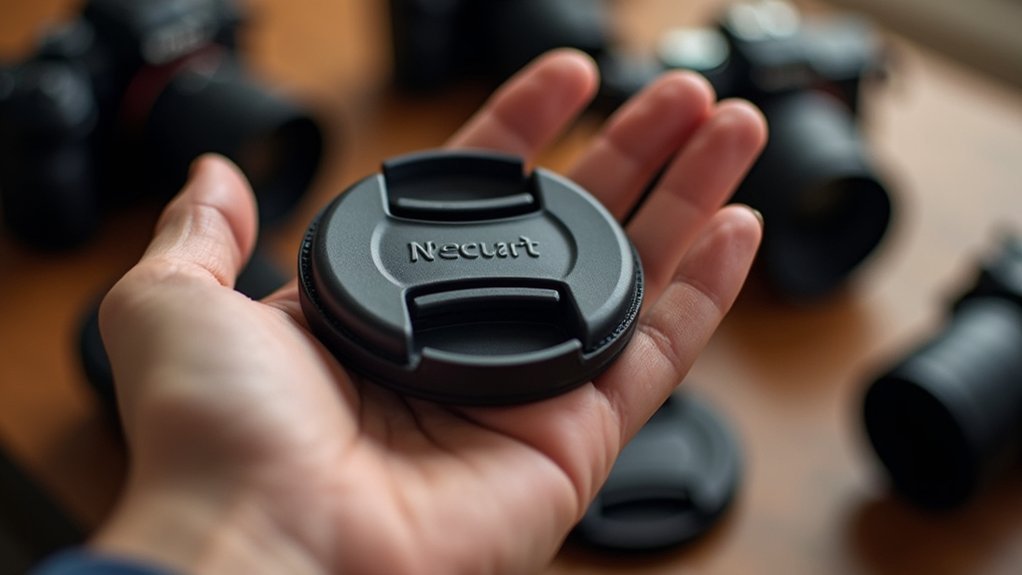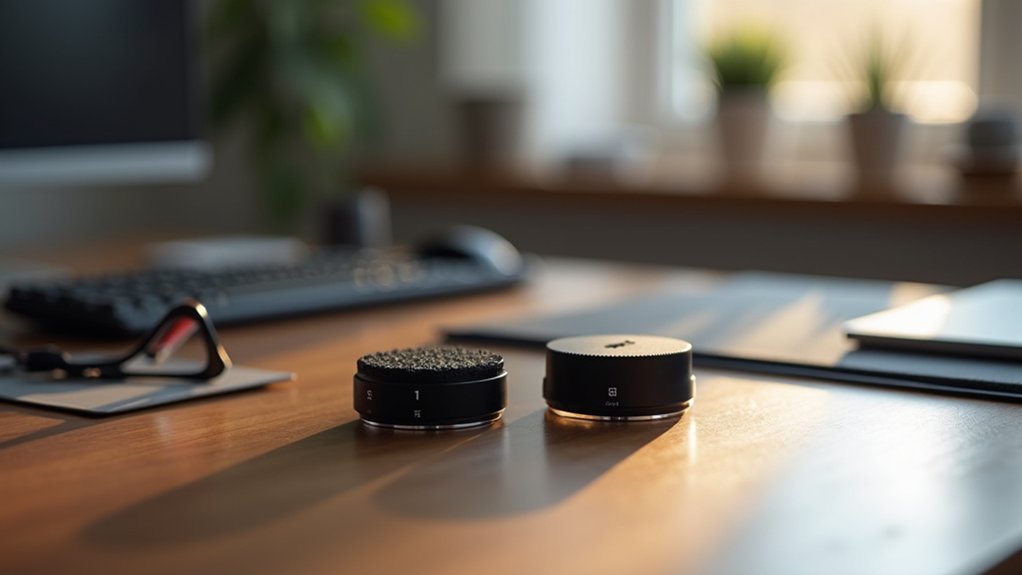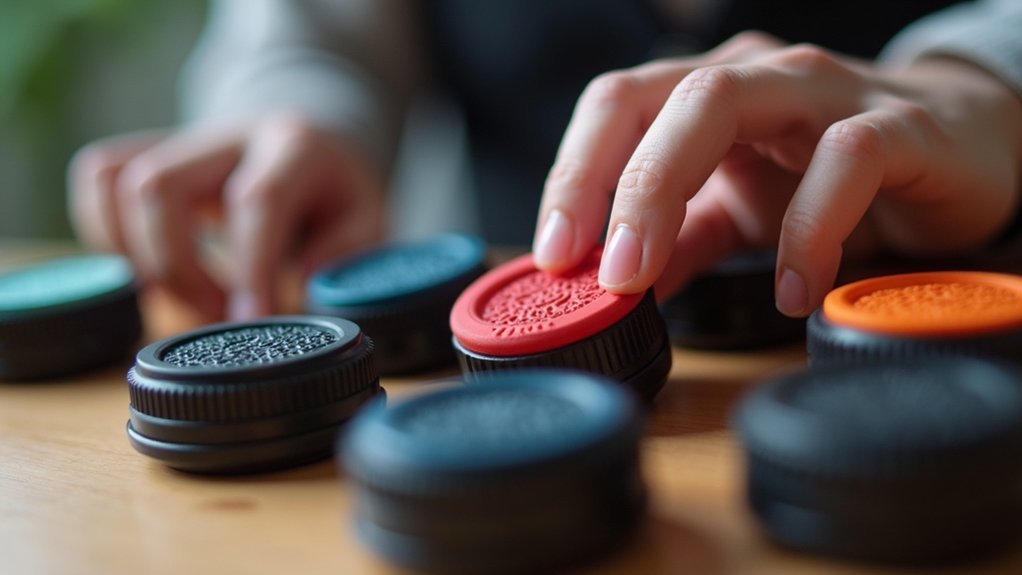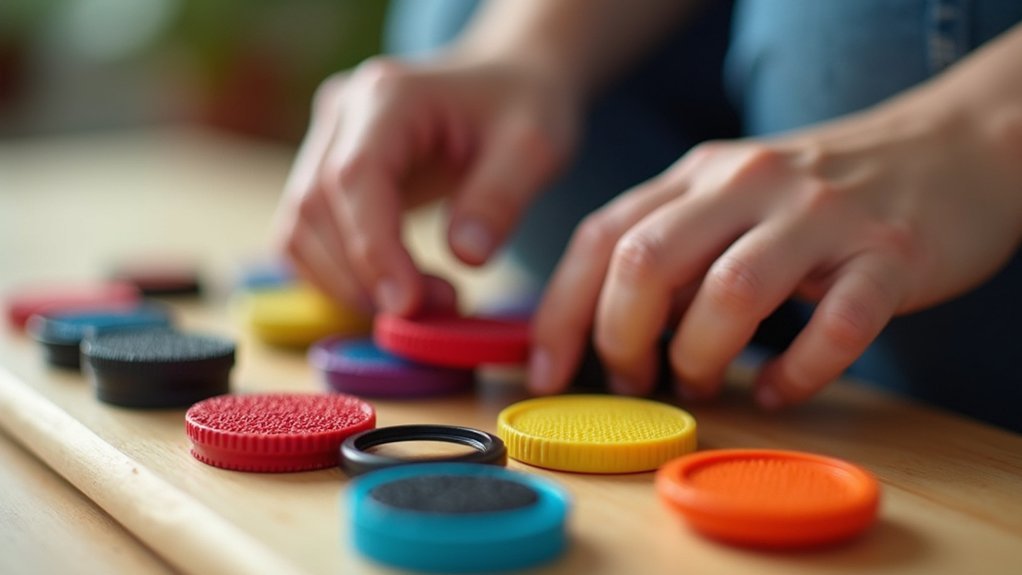Photographers with limited dexterity can now access several innovative lens cap solutions. Magnetic lens caps attach firmly without requiring pinch grips, while center-pinch mechanisms with textured surfaces offer improved handling. Consider tethered options to prevent drops, or try flip-up designs that eliminate the need for cap removal altogether. You’ll also find aluminum caps with knurled edges providing superior grip in challenging conditions. Discover how these adaptive tools can transform your photography experience.
Ergonomic Innovations in Lens Cap Design

While photographers often focus on their camera bodies and lenses, the humble lens cap has undergone remarkable ergonomic innovations in recent years.
You’ll now find caps with center-pinch mechanisms that make removal simpler, even with larger hands. These user-friendly designs incorporate finger-fit structures for enhanced grip and control.
Center-pinch lens caps accommodate photographers of all hand sizes, providing intuitive grip points for seamless handling during fast-paced shoots.
Modern lens caps feature textured or knurled edges that provide extra stability in various shooting conditions. Many manufacturers have introduced innovative materials that contribute to better grip and ergonomic feel. Some designs emphasize space-saving designs that fit easily in gear bags without adding bulk.
Canon’s patented barndoor-style cap offers a collapsible design for convenience, while tethered options guarantee you won’t lose your cap during shoots.
The focus on comfort and ease of use means today’s lens caps reduce hand strain while providing superior protection for your valuable glass.
Magnetic Solutions for Easier Handling
Countless photographers have embraced magnetic lens caps as a revolutionary solution to the frustrations of traditional twist-and-lock designs. You’ll find these caps attach seamlessly with a strong magnetic grip, requiring no threads or snaps—perfect if you have limited dexterity.
The benefits are substantial: rapid installation and removal, secure fit without accidental detachment, and the ability to stack filters and caps for compact storage. These caps are crafted from durable magnalium alloy that offers both strength and lightweight handling.
Many options feature water-, oil-, and fingerprint-resistant coatings, making maintenance easier.
Available from brands like Urth and Okko Pro in various sizes (67mm, 77mm, 82mm), these magnetic solutions typically cost between $55-60.
Some companies even offer environmental benefits, using sustainable packaging or planting trees with each purchase.
For photographers struggling with traditional lens caps, magnetic technology provides a simple yet elegant solution.
Smart Technology Integration for Accessibility

Beyond magnetic solutions, smart technology has revolutionized accessibility for photographers with dexterity challenges. Smart glasses with AI capabilities now offer hands-free operation through voice commands, eliminating the need to physically manage lens caps.
These wearables can recognize your equipment and provide audio guidance for lens changes. Products like Envision Glasses provide hands-free AI assistance through features like voice-activated controls for various accessibility needs.
Smart contact lens technology takes this further by tracking eye movements to control camera functions without manual manipulation. With embedded microLED displays, you can adjust settings with just a glance.
The integration of personalized AI algorithms learns your photography patterns, automating routine tasks that previously required fine motor skills.
These adaptive wearables combine prescription correction with smart features, ensuring you don’t need to juggle separate devices while working with camera equipment.
User-Tested Modifications That Make a Difference
How do photographers actually solve lens cap challenges in real-world situations?
Real-world solutions often outperform manufacturer designs when it comes to accessibility. These practical modifications have proven effective for those with limited dexterity:
- Attach cap tethers to prevent dropping and reduce frustration when you’re changing lenses frequently in dynamic shooting environments.
- Use protective lens tubes or armor instead of traditional caps to eliminate the need for precise finger movements.
- Store caps in dedicated pockets with easy-access openings rather than fumbling through a crowded camera bag.
- Modify existing caps by adding textured grips with silicone tape or rubber bands for improved handling, especially when you’re wearing gloves in cold conditions. The flip-up design found in products like Nightforce’s lens caps offers significant advantages for those with limited mobility, as they eliminate the need to completely remove the cap.
Customization Options for Enhanced Visibility and Grip

While standard lens caps serve their basic purpose, customization offers photographers greatly improved usability for those with dexterity challenges.
Aluminum caps with knurled edges provide superior grip, while textured rubber options offer similar benefits with added flexibility.
You’ll find CNC-machined aluminum caps can be laser-engraved with your lens information or personal details, making identification effortless even in low light.
For easier handling, consider caps with grooved designs that reduce suction during removal.
Material choice greatly impacts usability—Delrin’s low friction coefficient enables smooth installation, while TPU delivers excellent tactile feedback.
Full-color printing on rubber caps creates high-contrast visuals for quick identification.
Custom lens caps aren’t just aesthetic upgrades—they’re practical tools that transform handling for photographers with limited dexterity.
LenzBuddy™ offers options for adding focal length only customization for lens caps as a budget-friendly alternative to full customization.
Frequently Asked Questions
How Much Do Adaptive Lens Caps Typically Cost?
You’ll find adaptive lens caps generally range from $12.95 to $19.95, depending on design complexity, materials used, and brand. Custom options may cost more if they require specialized adaptations for your specific needs.
Can I Retrofit My Existing Lens Caps for Easier Handling?
Yes, you can retrofit existing lens caps by adding textured grips, silicone covers, or magnetic adapters. You’ll find DIY options like applying velcro strips or rubber bands that greatly improve handling without buying new caps.
Are Adaptive Lens Caps Available for Vintage Camera Systems?
Yes, you can find adaptive lens caps for vintage camera systems. While not specifically designed, you’ll have options like universal designs, step-up rings, or custom solutions that can accommodate your vintage lenses effectively.
Do Insurance Plans Cover Accessibility Modifications for Photography Equipment?
Most standard insurance policies don’t specifically cover accessibility modifications for photography equipment. You’ll need to seek custom policies or specialized riders to guarantee your adaptive tools are protected. Always verify coverage details beforehand.
How Do Weather Conditions Affect the Functionality of Magnetic Lens Caps?
Weather conditions impact your magnetic lens caps in several ways: extreme cold slightly reduces magnetic strength, moisture can interfere with contact points, and dust may affect adhesion. However, most quality caps maintain functionality despite these challenges.
In Summary
You’ve discovered there’s no need to struggle with lens caps anymore. Whether you’re choosing magnetic attachments, ergonomic designs, or smart technology solutions, you’ll find options specifically designed for your dexterity challenges. Remember, customization is key—high-visibility colors and textured grips can transform your photography experience. Don’t hesitate to test different modifications until you find what works best for your unique needs.





Leave a Reply